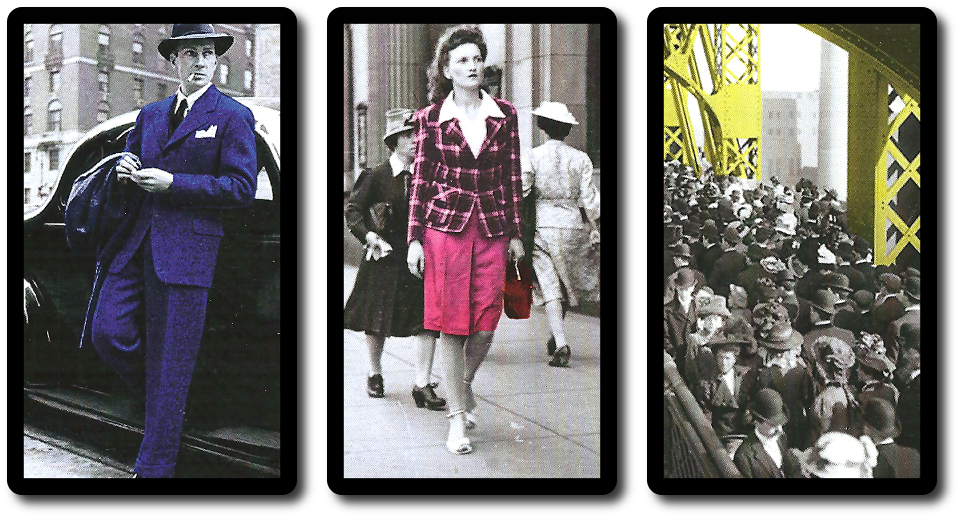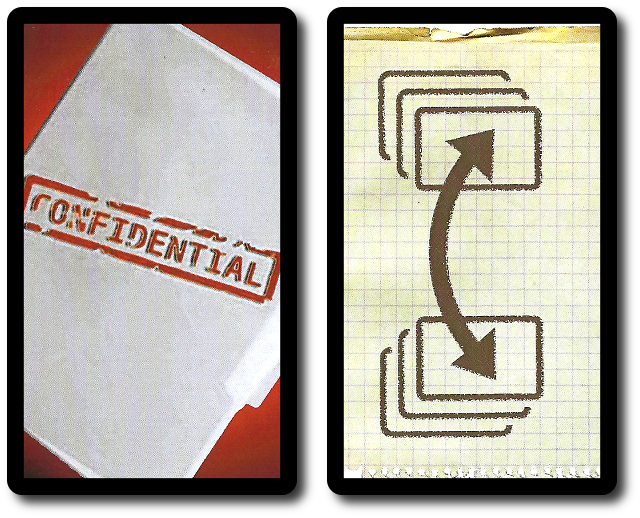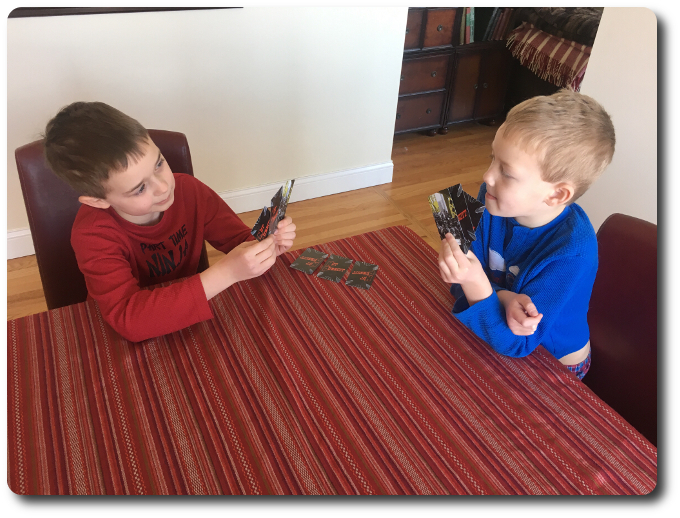Please Take Note: This is a review of the final game, but it might change slightly based on the success of the Kickstarter campaign. The game is being reviewed on the components and the rules provided with the understanding that “what you see is not what you might get” when the game is published. If you like what you read and want to learn more, we encourage you to visit the publisher’s website or visit the Kickstarter campaign. Now that we have all that disclaimer junk out of the way, on with the review.

The Basics:
- For ages 6 and up (publisher suggests 8+)
- For 1 to 10 players
- Approximately 15 minutes to complete
Geek Skills:
- Logical & Critical Decision Making
- Memorization
- Hand/Resource Management
- Bluffing and Misdirection
Learning Curve:
- Child – Easy
- Adult – Easy
Theme & Narrative:
- The streets of New York in the 1940’s are full of stories and danger
Endorsements:
- Gamer Geek rejected!
- Parent Geek approved!
- Child Geek approved!
Overview
New York City is full of hopes, dreams, and corruption. Behind each brightly lit street is a shadowy alley where anyone can make a backstreet deal. The line between “good” and “bad” is blurred once you start compromising your values and justifying your actions. In this game, you’re only interested in clues. You’ll let the newspapers cover whatever passes as “truth”.
Hot Pursuit, designed by Derik Duley and to be published by Lagniappe Games, will reportedly be comprised of 32 cards. As this is a review of a prepublished game, I cannot comment on the game component quality.
About the Cards
There are three primary card types in the game. These cards represent people both of importance and the seemingly endless crowd of New York City. These cards are used differently in the games and have different names, but the card is always the same. The blue man can be a detective or a spy, the pink lady can be a jewel thief or a scorned lover, and the sea of people serves to keep the story afloat and flowing.

There are other cards, as well. A Confidential Document card, for example, that is used to represent important and incriminating papers, be it for spies or corrupt government officials. There is also a Reminder card that can be used to help remind the player when turns end or actions that need to be taken.

Players hold their cards in their hand two different ways. The first is the traditional way, wherein the back of the cards are visible to the player’s opponents and only the player can see what they are holding (referred to as “facing in”). The second way is holding a card so the back of the card is facing the player (referred to as “facing out”). This allows the player’s opponents’ to see what cards they are holding. Players will be holding cards both ways during the game, often maintaining a hand of cards that they can see and cannot see.
Players will eventually have fewer and fewer facing them. Only when the player is able to meet certain conditions will they be able to have all the cards facing them again. For example, trading their entire hand of cards to an opponent or having a specific number of facing cards. Sometimes a player will be able to see the card they are passed, while other times the card they now own will be a complete mystery to them.
Big City, Lots of Crime
Hot Pursuit is set thematically in the 1940’s on the streets of New York City. Crime is rampant and each case is unique. In game terms, Hot Pursuit is 4 different games and each game has slightly different rules. Some games require a larger number of people and others can be played by only 1 individual. Each of the games are summarized here.
Cut Out the Corruption (for 1 player)
The lady card is referred to as the “Corrupt Commissioner” and the gent is the “Dirty Detective”. The Crowd cards are used, as is the Confidential Document card.
The challenge the player must now attempt to overcome is to continue to shift cards back and forth between 3 stacks using the cards they have in their hand. The Corrupt Commissioner and Dirty Detective work against the player by forcing cards to shift and taking cards out of the player’s hand.
The player wins when the Corrupt Commissioner, the Dirty Detective, and the Confidential Document cards are in the same stack. The player has successfully connected the dots and put the culprits in the same room with no alibi to save them from the judge.
To Catch a Thief (for 2-players)
The lady card is a “Jewel Thief” and the gent is the “Private Detective” hot on her heels. The Crowd cards represent the population of New York and the difficulty of finding clues.
This game introduces a non-playing character named Otto who is a snitch. He provides information and helps cards flow between players. Otto is not always reliable as far as accuracy is concerned, but he always delivers.
This game is a race between the 2 players who are both acting as the Private Detective. Cards are traded back and forth between players and Otto. Cards given are turned away from the player so the opponent knows almost as much information as the player.
The game comes to an end when a player has both the Jewel Thief and the Private Detective in their hand facing them. The thief has been caught and the winner is the better detective.
Big City Matchmakers (for 3 to 10-players)
This game is about crimes of the heart. The players will be working together and on behalf of a friend who saw the lady of his dreams and now wants to find her. Unbeknownst to all is that there is a jealous boyfriend who will stop at nothing to make certain their meeting never happens.
The lady represents the “Pink Lady” of your friend’s dreams and the gent is the player’s “Love Struck Friend” who has enlisted their help to find her. The crowds represent the large population of New York the players will have to look through.
Cards are gathered and the Pink Lady and the Love Struck Friend are randomly dealt along with the other cards. Whichever players was dealt the Pink Lady will be playing the role of the “Jealous Boyfriend”. The player who is dealt the Love Struck Friend represents the hopeful lover who is searching for the lady.
The player who is the Jealous Boyfriend closes their eyes (or leaves the room) and the Love Struck Friend identifies themselves to everyone else as quietly as possible. Then the Jealous Boyfriend opens their eyes and the game begins.
On their turn, a player will either pass their hand to another player, force everyone to pass 1 card, or trade 1 card with another player. Any cards that are received are not looked at unless the player has a certain number of cards facing out.
The Jealous Boyfriend wins the game if the Love Struck Friend card and the Pink Lady card are ever in the same hand of cards of a player who is NOT the Love Struck Friend.
The Love Struck Friend and everyone else wins if the Pink Lady and the Love Struck Friend card are both in the Love Struck Friend player’s hand.
Spy Hunter (for 2 teams comprised of 4-10 players)
This game takes place in 1942 and pits a German spy against an American spy. This is a game about espionage during the time of World War II. Danger is everywhere and there is little to no trust.
The lady is the “German Spy” and the gent is the “United States Spy”. What is being fought over is the Confidential Document card. The game takes place on the streets of New York, between the busy hustle and bustle of the populace represented by the crowds.
Players split into two groups: German Spy and United States Spy teams. Teams sit opposite of each other and should be as even as possible. Each player is given 2 Crowd cards and are dealt a third that might or might not be the lady, the gent, or the Confidential Documents.
On a player’s turn, they will either exchange hands with an opponent, force everyone to pass 1 card to the left or right, or trade 1 card with an opponent of their choice. Cards given to a player are not looked at and instead or added to their hand facing out, unless the player has reached their maximum number of facing out cards. In which case, their hand is rotated.
Game play continues until 1 player has either the lady or the gent and the Confidential Documents facing them. If an opponent handed you a card that stopped the game, that opponent has blown their cover and is out of the game. If the game stops and the player is holding their agent, they have blown their own cover and are out of the game. If the games stops with the player holding the opponent’s agent, the player gets to decide who to eliminate.
When a player is removed from the game, some of the cards are collected and redistributed. A team wins if they eliminate all of their opponents.
Making Your Own Game
Hot Pursuit is, at its core, a group of cards with distinct faces. These can be used to create different games than those provided. Because the cards use pictures, they are prefect for designing a game around a story instead of icons or values. A creative mind need not work very hard to begin creating the framework of another great game that can be played by 1 or more players.
To learn more about Hot Pursuit, visit the publisher’s website or visit the Kickstarter campaign.
Final Word
The Child Geeks liked the different games, but the Jewel Thief game, wherein they attempted to catch the dubious character before their opponent, was their favorite. According to one Child Geek, “I like it the best because it feels like a race. I can picture myself running around trying to catch them.” The games were all found to be easy enough to teach and to play by our youngest available Child Geeks, allowing unskilled players to try their hand at the game. According to one of our youngest Child Geeks, “You just need to watch and listen.” When all the games were over, the Child Geeks voted to approve Hot Pursuit.

Each of our Child Geeks found at least one game they enjoyed playing, if not two
The Parent Geeks liked the games, as well, and were very pleased with the possibilities of making their own. According to one Parent Geek, “I like games that leave a backdoor open to players to design their own rules and game play. Makes me feel closer to the game and more interested in playing it.” The Parent Geeks were also big fans of the game’s emphasis on memory and deduction, rather than math and reading. As one Parent Geek put it, “This let’s the game be played by my youngest children all the way up to my oldest friend.” The Parent Geeks all voted to approve Hot Pursuit.
The Gamer Geeks were less impressed, finding the game to be a mix of interesting ideas poorly executed. According to one Gamer Geek, “I like the premise of the game, but it just feels like lazy game design. Passing certain cards around and declaring the winner when two or more cards are together is way too close to Hot Potato for my liking.” Another Gamer Geek said, “Some good ideas, but they feel like they are half-baked. Each time I play I keep asking myself, is this it?” None of the Gamer Geeks liked the games enough to approve Hot Pursuit.
Hot Pursuit, like any collection of games, is dependent on the game components being both generic and specific enough to allow for a narrative and theme built around lots of different rules. This is not as hard as it sounds when we consider the standard deck of 52 playing cards. In the case of Hot Pursuit, we are looking for specifics that tie in a Noir fiction narrative to deduction game play. I’d say it works, but I also understand why the Gamer Geeks didn’t see much to the game. The problem is, there’s not enough customization and uniqueness. There are only 3 major cards to ever look for and a large number that are meaningless (the Crowds, in this case). Passing cards back and forth over and over again can get tedious.
But tediousness is exactly what you will feel if you are not playing the games correctly. The games are designed to have you dig and search forever until you start connecting the dots. Players must pay attention, remember where cards are (or aren’t), and bring it all together. This is where the joy of the game lies. Figuring things out, piecing small scraps of information together, and making logical decisions. You really have to be a detective in the game and that takes work.
As far as deductive card games go, this is not a bad one. I like the idea that new games can be easily made thanks to the game components being both specific and generic enough to accommodate new ideas with ease. While I was not a fan of all the games, Hot Pursuit never the less caught my attention. The game is, first and foremost, what you make of it. This will appeal to some and wrinkle the nose of others.
This is a paid for review of the game’s final prototype. Although our time and focus was financially compensated, our words are our own. We’d need at least 10 million dollars before we started saying what other people wanted. Such is the statuesque and legendary integrity of Father Geek which cannot be bought except by those who own their own private islands and small countries.
Discover more from Father Geek
Subscribe to get the latest posts sent to your email.





